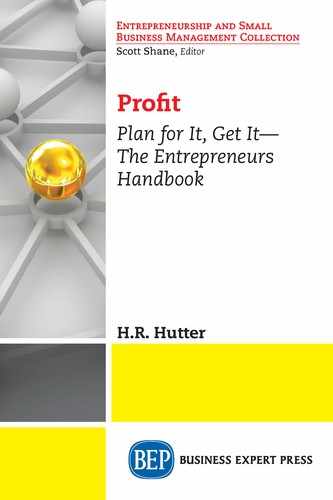CHAPTER 2
The Formula
Now that we have got through the hardest chapter, we are going to look at a formula that will let you have a new and exciting look at your business. This formula will let you calculate your breakeven and your net profit, and allow you to see what happens if you change costs from a variable cost to a fixed cost or vice versa. It will also allow you to calculate your profit based upon any of these changes.
Breakeven |
BE |
Variable cost as a percent of revenue |
V |
Fixed costs in dollars |
F |
Sales or revenue |
S |
Profit |
P |
First let us calculate the breakeven for the day care center referred to in Chapter 1.
BE = F/1 − V
The key here is that you use fixed costs as a dollar amount and variable costs as a percentage of revenue expressed as a decimal amount. If you go back and retrieve the numbers from the day care center, you will obtain the following: revenue ($820,342.82), fixed costs ($337,119.36), variable costs ($346,423.78), or 42.2 percent of the revenue. Expressed as a decimal this looks like .422. Using our formula, we can calculate our breakeven as follows:
BE = $337,119.36/(1 − 0.422) = $337,119.36/0.578 = $583,251.48
With this step completed, we can now check our profit formula with the actual numbers from the P&L.
P = (S − BE) × (1 − V)
S = $820,342.82, BE = $583,251.48, and (1 − V) = 0.578
Does it equal the $136,799.68 from the CPA’s P&L statement?
P = ($820,342.82 − $583,251.48) × 0.578
P = $237,091.34 × 0.578 = $137,038.79 when compared with $136,799.68. This difference is because of rounding off.
The tail end of the breakeven formula (1 − V%) is of utmost importance. Some consider it the incremental profit multiplier. The fact you must take into account is that once you are at breakeven or above, every additional dollar will turn into profit at the rate of 57.8 percent. This is because you already have your fixed costs covered. Let’s look at an example. If we add an additional $50,000 in revenue and manage the facility as we have been, our revenue will be $870,342.82. Our fixed costs stay the same (well because that is why they are called fixed costs) and our variable costs will still be 42.2 percent as we will manage the facility as before. Using the incremental profit multiplier, we can calculate the additional profit as being $50,000 times 0.578 (1 − V%) or $28,900. This will give us a new total profit of $165,938.79. The total P&L will be as follows:
Revenue with added sales |
$870,342.82 |
Fixed costs |
$337,119.36 |
Previous variable costs |
$346,423.78 (42.2% of revenue) |
Additional variable costs |
$21,100 (42.2% of $50,000) |
Total cost Item 2, 3, and 4 |
$704,643.06 |
Profit (Revenue − cost) |
$165,699.76 |
This formula is very powerful as it allows you to simply and easily analyze your business. For instance, you can look at whether or not you should shift an item from being a variable cost to a fixed cost. We did this in our restaurants. As we became profitable, we could convert some of our leases, where we paid a fixed amount and an overage to the landlord, to a bank loan. This decreased our variable cost and increased our fixed cost. Furthermore, it increased the incremental profit multiplier, so that if we increased our sales, our profits went up more. This helped us exponentially as we could then add more specials that increased our customer counts, which even gave us more profit. Generally, the more above the breakeven your business is, the better it is to try and lower your variable costs.
Now let’s look at an example for the day care mentioned previously. We will assume that we are going to not supply our own automobile and transportation and are going to outsource it for 1.8 percent of our revenue. Therefore, our fixed costs will go down $17,578.33 ($338.04/week) or now $6145; however, our variable costs will go up to 44 percent. Is this outsourcing profitable or not?
Revenue |
$15,775.77 |
Fixed costs |
$6,145 |
Variable costs (44%) |
$6941.34 |
Total cost |
$13,086.34 |
Profit |
$2,689.43 ($58.68 better) |
Let’s use the formula BE = $6145/(1 − 0.44) = $10,973.14
Profit = $15,775.77 − $10,973.14 × (1 − 0.44) = $2,689.47
The advantage of having a condensed weekly P&L is that it makes it easier to analyze changes that you are considering. Just adjust your fixed and variable costs and run the formula again.
We spent a lot of time in our restaurant business seeing if lowering the price on some items that generated extra revenue offset the higher food cost. This is just one example of the many scenarios we ran. With many adjustments, we were able to make about 20 percent net on a $1,200,000 store. We will see more examples in the chapter on metrics.
I suggest that you run different scenarios for your business and see what you can come up with.
Well you have done it; you have made it through the hardest and most homework necessary part of the book. I would like to stress that you go back over Chapter 1 and 2 a few times, so that you feel comfortable with them. The Behavioral Science gurus say that it will take a normal person five times to feel comfortable with these formulas. My wife (a retired fourth grade schoolteacher) checked this formula and was able to understand it. It took her about one and a half hours.
